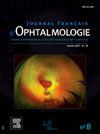Lome(多哥)CHU-campus眼科初级开角青光眼晚期患者的社会流行病学、临床和治疗概况
IF 1.1
4区 医学
Q3 OPHTHALMOLOGY
引用次数: 0
摘要
目的:本研究的目的是确定晚期原发性开角型青光眼患者的社会流行病学、临床和治疗概况。病人和méthodeNous已经进行了回顾性研究和横向与病人的采访,2013年1月1日到2018年12月31日,即为期六年。其中包括在晚期患者GPAO 18岁及以上随访中洛美CHU-Campus耳环眼科处至少六个月,并曾经接受采访回答。结果102例患者符合纳入标准,平均年龄为55.65±14.71岁,以男性为主(56.86%)。在58.82%的病例中,月收入估计较低。85.29%的患者受过教育。在患者中,58.82%的人报告说,由于视力下降,他们被诊断为OLPD。在平均5.83年的发展过程中,单眼失明和双眼失明的发生率分别为21.78%和22.77%。结论:如果没有适当的治疗,ALPD是一种不可避免地发展为失明的疾病。这项工作确定了Lome CHU-campus晚期PAD患者的概况。了解这一概况将有助于实施有效的OTP管理的新策略。本研究的目的是确定晚期POAG患者的社会流行病学、临床和治疗概况。在6年的时间里,我们进行了包括患者访谈在内的回顾性横断面分析。本研究的时间范围从2013年1月1日延长到2018年12月31日。18岁及以上的进行性POAG患者,在CHU-Campus de Lome眼科进行了至少6个月的随访,并同意接受采访。结果102例患者符合纳入标准,平均年龄为55.65±14.71岁,男性占多数(56.86%)。在58.82%的案例中,月收入被认为很低。85.29%的患者接受了教育。在患者中,58.82%的人表示,他们在视力下降后被诊断为POAG。在平均进展5.83年之后,单眼失明率和双眼失明率分别为21.78%和22.77%。在45%的病例中使用了三联疗法。结论POAG是一种在缺乏适当管理的情况下不可避免地发展为失明的疾病。这项研究使我们能够在CHU-Campus de Lome确定晚期POAG患者的概况。了解这一概况可能有助于建立有效管理POAG的新战略。本文章由计算机程序翻译,如有差异,请以英文原文为准。
Profil socio-épidémiologique, clinique et thérapeutique du patient au stade avancé du glaucome primitif à angle ouvert dans le service d’ophtalmologie du CHU-campus de Lomé (Togo)
Objectif
Le but de ce travail était de déterminer le profil socio-épidémiologique, clinique et thérapeutique des patients au stade avancé du glaucome primitif à angle ouvert (GPAO).
Patients et méthode
Nous avons mené une étude rétrospective et transversale avec interview des patients du 1er janvier 2013 au 31 décembre 2018 soit sur une période six ans. Étaient inclus les patients au stade avancé de GPAO âgés de 18 ans et plus suivis dans le service d’ophtalmologie du CHU-Campus de Lomé pendants au moins six mois et qui avaient accepté de répondre à l’interview.
Résultats
Cent deux patients avait répondu aux critères d’inclusions, dont l’âge moyen était de 55,65 ± 14,71 ans avec une prédominance masculine (56,86 %). Le revenu mensuel était estimé bas dans 58,82 % des cas. Les patients étaient instruits dans 85,29 % des cas. Parmi les patients, 58,82 % disaient avoir été diagnostiqués du GPAO au décours d’une baisse de l’acuité visuelle. Le taux de cécité monoculaire et binoculaire avait représenté respectivement 21,78 % et 22,77 % après une durée moyenne d’évolution de 5,83 ans. La trithérapie était le schéma thérapeutique le plus utilisé, dans 45 % des cas.
Conclusion
Le GPAO est une maladie qui évolue inéluctablement vers la cécité en absence d’une prise en charge adéquate. Ce travail a permis de déterminer le profil du patient atteint de GPAO au stade avancé au CHU-campus de Lomé. La connaissance de ce profil pourra contribuer à mettre en place une nouvelle stratégie de prise en charge efficace du GPAO.
Purpose
The goal of this study was to determine the socio-epidemiological, clinical and therapeutic profile of patients with advanced POAG.
Patients and methods
Over a six-year period, we performed a retrospective cross-sectional analysis including patient interviews. The time frame for this study extended from January 1, 2013, to December 31, 2018. Patients with advanced POAG aged 18 years and over who had been followed in the ophthalmology department of the CHU-Campus de Lomé for at least six months and who agreed to be interviewed were included.
Results
One hundred two (102) patients met the inclusion criteria, with a mean age of 55.65 ± 14.71 years and a male predominance (56.86%). Monthly income was considered low in 58.82% of cases. Patients were educated in 85.29% of cases. Among the patients, 58.82% said they had been diagnosed with POAG after a decrease in visual acuity. The rate of monocular and binocular blindness was 21.78% and 22.77% respectively, after a mean progression time of 5.83 years. Triple therapy was used in 45% of cases.
Conclusion
POAG is a disease that inevitably progresses to blindness in the absence of adequate management. This study has enabled us to determine the profile of patients with advanced POAG at the CHU-Campus de Lomé. Knowledge of this profile might help to establish a new strategy for effective management of POAG.
求助全文
通过发布文献求助,成功后即可免费获取论文全文。
去求助
来源期刊
CiteScore
1.10
自引率
8.30%
发文量
317
审稿时长
49 days
期刊介绍:
The Journal français d''ophtalmologie, official publication of the French Society of Ophthalmology, serves the French Speaking Community by publishing excellent research articles, communications of the French Society of Ophthalmology, in-depth reviews, position papers, letters received by the editor and a rich image bank in each issue. The scientific quality is guaranteed through unbiased peer-review, and the journal is member of the Committee of Publication Ethics (COPE). The editors strongly discourage editorial misconduct and in particular if duplicative text from published sources is identified without proper citation, the submission will not be considered for peer review and returned to the authors or immediately rejected.

 求助内容:
求助内容: 应助结果提醒方式:
应助结果提醒方式:


